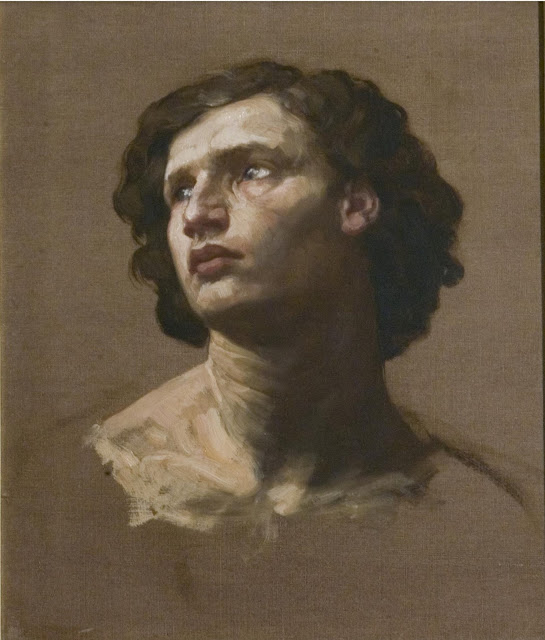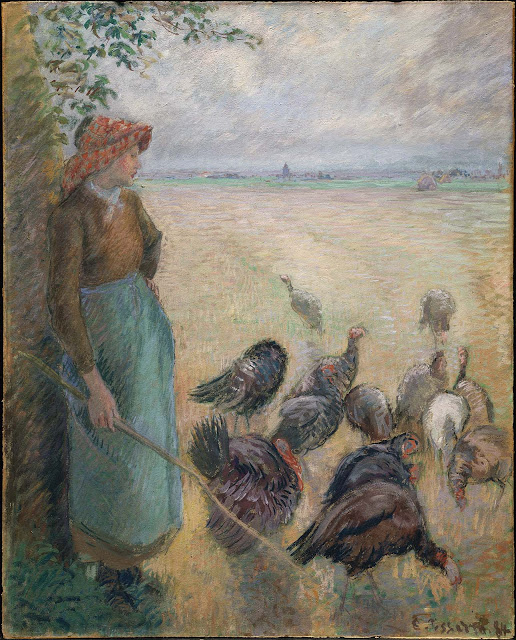 |
| follower of Jacques-Louis David Portrait of an Elderly Lady ca. 1820 oil on canvas Walters Art Museum, Baltimore |
 |
| Honoré Daumier The Prison Choir ca.1860 oil on panel Walters Art Museum, Baltimore |
 |
| Honoré Daumier The Loge ca. 1856-57 oil on panel Walters Art Museum, Baltimore |
 |
| Edgar Degas Degas's Father listening to Lorenzo Pagans playing the Guitar ca. 1869-72 oil on canvas Museum of Fine Arts, Boston |
 |
| Edgar Degas Portrait of the Duchessa di Montejasi (Degas's Aunt Fanny) and her daughters Elena and Camilla ca. 1876 oil on canvas Museum of Fine Arts, Boston |
"The feminine character, and the ideal of femininity on which it is modelled, are products of masculine society. The image of undistorted nature arises only in distortion, as its opposite. Where it claims to be humane, masculine society imperiously breeds in women its own corrective, and shows itself through this limitation implacably the master. The feminine character is a negative imprint of domination. But therefore equally bad. Whatever is in the context of bourgeois delusion about nature, is merely the scar of social mutilation. If the psychoanalytical theory is correct that women experience their physical constitution as a consequence of castration, their neurosis gives them an inkling of the truth. The woman who feels herself wounded when she bleeds knows more about herself than the one who imagines herself a flower because that suits her husband. The lie consists not only in the claim that nature exists where it has been tolerated and adapted, but what passes for nature in civilization is by its very substance furthest from all nature, its own self-chosen object. The femininity which appeals to instinct, is always exactly what every woman has to force herself by violence – masculine violence – to be: a she-man. One need only have perceived, as a jealous male, how such feminine women have their femininity at their finger-tips – deploying it just where needed, flashing their eyes, using their impulsiveness – to know how things stand with the sheltered unconscious, unmarred by intellect. Just this unscathed purity is the product of the ego, of censorship, of intellect, which is why it submits so unresistingly to the reality principle of the rational order. Without a single exception feminine natures are conformist. The fact that Nietzsche's scrutiny stopped short of them, that he took over a second-hand and unverified image of feminine nature from the Christian civilization that he otherwise so thoroughly mistrusted, finally brought his thought under the sway, after all, of bourgeois society. He fell for the fraud of saying 'the feminine' when talking of women. Hence the perfidious advice not to forget the whip: femininity itself is already the effect of the whip. The liberation of nature would be to abolish its self-fabrication. Glorification of the feminine character implies the humiliation of all who bear it."
– Theodor Adorno, from Minima Moralia: Reflections from Damaged Life, published in German in 1951, translated by E.F.N. Jephcott and published in English in 1974
 |
| Edgar Degas Portrait of Estelle Balfour (Degas's blind cousin, a war widow) ca. 1863-65 oil on canvas Walters Art Museum, Baltimore |
 |
| Jean-François Millet Peasant Girl Daydreaming 1848 oil on panel Museum of Fine Arts, Boston |
 |
| Jean-François Millet Women Sewing by Lamplight ca. 1853-54 oil on panel Museum of Fine Arts, Boston |
 |
| Alphonse Legros Head of a Man 1876-77 oil on canvas Victoria & Albert Museum |
 |
| Ernest Meissonier Two Soldiers 1849 oil on panel Museum of Fine Arts, Boston |
 |
| Camille Pissarro Turkey Girl 1884 tempera on paper Museum of Fine Arts, Boston |
 |
| Pierre Puvis de Chavannes Hope 1872 oil on canvas Walters Art Museum, Baltimore |
 |
| Édouard Manet Portrait of René Maizeroy ca. 1882 pastel Museum of Fine Arts, Boston |
 |
| Édouard Manet Music Lesson 1870 oil on canvas Museum of Fine Arts, Boston |